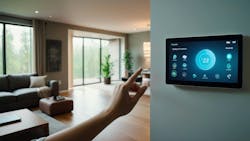Is Your Current HVAC System Holding Back Energy Efficiency? Make it Smarter!
As critical as an HVAC is in any building, it often doesn’t perform as well as it should. Heating and cooling are typically some of the largest sources of energy consumption, leading to high costs and carbon footprints. While there are many potential solutions to that issue, a smart HVAC is one of the most promising.
Steps like regular maintenance and thoughtful insulation are crucial in optimizing HVAC efficiency. However, you may have tried conventional methods and still struggle to get your building’s power usage where it should be. In such a scenario, smart technology is likely the answer.
What Is a Smart HVAC System?
Smart HVAC is a broad category covering the integration of technologies like the Internet of Things (IoT) and artificial intelligence (AI) in HVAC systems. While the specifics can vary, all such innovations offer valuable improvements through automation, data analytics, and wireless connectivity.
Many homes already use these technologies on a small scale. Smart thermostats are the most popular example, with more than 230 million of them shipping in 2024 alone. However, much larger, more complex systems are a possibility, too, and these yield even more significant results.
A broader building automation project may deploy smart thermostats, IoT-connected furnaces, and an array of sensors throughout the ventilation system. All individual endpoints can connect so each can respond to the other’s real-time data. Automated control solutions would then adjust HVAC operations according to this information.
In all its forms, smart HVAC makes managing a building easier than ever. More importantly, it also enables higher efficiency standards through a few key advantages.
Real-Time Adjustments
The primary efficiency driver in a smart HVAC is its ability to react to real-time data. IoT thermostats and similar building automation systems control heating based on actual conditions instead of following a schedule. As a result, they maintain optimal temperatures, humidity, and airflow without any wasted power.
Schedule-based alternatives often run for longer than necessary, leading to waste. Alternatively, they may remain idle for too long, causing them to work harder when they do turn on to compensate for significant temperature gaps. Even systems using environmental sensors have similar shortcomings if they only measure conditions along a schedule instead of analyzing them in real time.
By making minute adjustments as soon as necessary, IoT-based HVAC uses as little electricity as possible. Such precision is only achievable with real-time data analytics, so conventional alternatives cannot compete.
[Related: Revolutionizing Facility Management with Smart Building Technology]
Optimized Maintenance
Smart HVAC’s data analysis extends beyond the building’s internal conditions. AI models can also detect subtle changes in the equipment’s performance, indicating the need for repairs. They can then alert technicians to fix the issue before it causes larger problems—a practice known as predictive maintenance.
Predictive care is often portrayed as a way to save money, but it also has efficiency benefits. By enabling earlier repairs, it ensures HVAC systems remain in top condition for as long as possible, preventing disrepair from causing inefficiencies.
Take air compressor filtration, for example. Clogged filters can cause pressures to drop, forcing the compressor to work harder to complete basic operations. Smart sensors near the filter can prevent this by warning technicians as soon as buildup causes a detectable drop in air pressure. Manual inspections can technically do the same, but AI can recognize such changes before they’re noticeable to humans, extending the benefits.
Detailed Insights
You can use smart HVAC equipment to achieve broader efficiency improvements, too. Over time, these technologies will generate a wealth of data on the HVAC system’s operations. AI can analyze this information to highlight trends suggesting unresolved inefficiencies or changes that could make the building more efficient.
Ongoing review like this essentially provides a continuous energy audit. Considering mandatory audits typically produce power savings between 2.5% and 4.9%, performing similar inspections repeatedly could lead to significant improvements. Even if the results are modest, every gain represents saved money.
This smart HVAC use case is more impactful when you use it to create a digital twin—a virtual representation of a real-world system centered around specific data. Machine learning models can simulate various changes in the HVAC system’s digital twin to identify which solutions yield the biggest savings. You find the ideal path forward without trial and error as a result.
[Related: How IoT Sensors and AI are Revolutionizing Smart Buildings]
Key Considerations for Implementing Smart HVAC
Of course, these benefits don’t come automatically. It takes careful planning and a few implementation best practices to use smart HVAC equipment to its full potential. That begins with determining what specific technologies you want to integrate into your building.
A home might only need a single smart thermostat, while office buildings or factories would benefit from more complex networks of individual IoT sensors. In general, the more automated features and IoT endpoints a system has, the more helpful it will be. At the same time, increased complexity leads to higher costs, so it’s important to compare the expected returns with a project’s budget.
When designing a smart HVAC system, you must also ensure all devices are compatible. 5G support is preferable, as these networks can support up to one million devices per square kilometer, making them ideal for complex IoT solutions. All endpoints must also share a common control technology, such as Matter or Zigbee.
Cybersecurity is another concern with IoT devices. Smart gadgets are popular hacking targets, as they usually lack strong built-in controls and can give attackers access to more sensitive systems. When the FCC cybersecurity labeling program takes effect, you can look for endpoints with this label to ensure higher security. Apart from that, enabling encryption, changing default passwords, turning off automatic connections, and using multi-factor authentication for all IoT devices will help.
Smart Technologies Unlock New Possibilities
Smart HVAC is a relatively new but promising field. As it develops and new technologies emerge, it will become an even more impactful way to drive energy efficiency. Capitalizing on these benefits now will help you meet the growing environmental needs of tomorrow.
There is no one-size-fits-all solution for building efficiency, but the IoT and AI can help in virtually any project. The first step to acting on that potential is learning about how these innovations can help.
About the Author

Emily Newton
Emily Newton is an industrial and tech journalist passionate about how technology is revolutionizing each sector. She has been writing and editing professionally for more than five years and is the editor-in-chief of Revolutionized.
